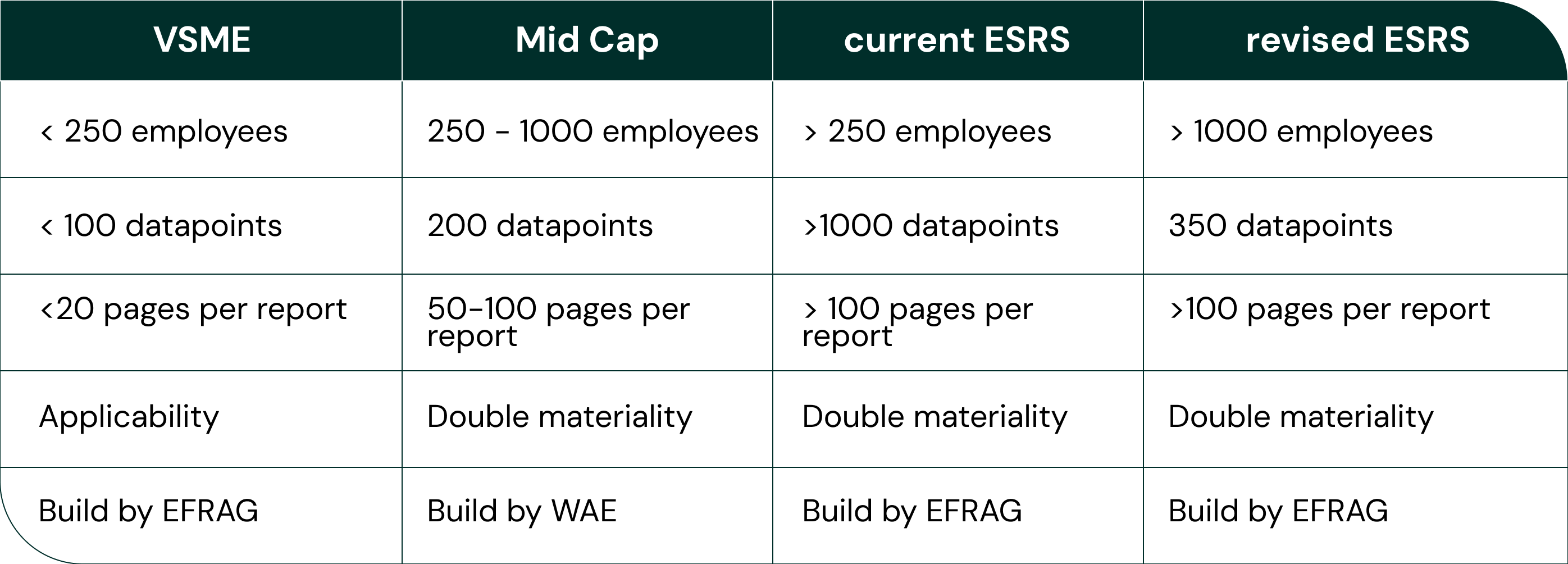Last May, a study carried out by the WeAreEurope collective with hundreds of European companies revealed that 91% of companies consider that ESG reporting is necessary to improve the transparency and comparability of businesses. However, the current European standards (ESRS, VSME) are not adapted to all companies.
The Mid Cap framework is an intermediate framework, which acts as a bridge between ESRS and VSME, specially designed for SMEs and ETIs wishing to produce a streamlined sustainability report. In this article, discover this brand new framework and how to use it in your business.
Everything you need to know about the Mid Cap framework
What upheavals for corporate transparency in 2025! Publication of the very first CSRD reports at the beginning of the year, full questioning of the framework by the Omnibus proposal at the end of February, delay of 2 years for companies in waves 2 and 3 with the Stop the Clock provision in April, new version of the ESRS in August, rejection of the compromise in October...
Who created the Mid Cap framework?
It is in this context of constant changes in current events that a collective of companies has been created in order to defend the fundamental values of the European Union and working for a fairer, greener and more democratic future. It is the WeAreEurope collective, bringing together committed professionals unable to sit idly by in the face of the ecological backlash coming from European institutions.

Thus, its members met in order to determine the means to guide European companies on the path to sustainability without questioning their competitiveness. In particular, they decided to propose a new framework, intermediate between ESRS and VSME, for companies that need a compass for their reporting. This is how the Mid Cap standard was born.
What businesses can use the Mid Cap report?
If you are a company with more than a thousand employees, you are unlikely to miss out on CSRD obligations. If you are a company with less than 250 employees, you are fortunate to be able to count on a framework adapted to your reporting capabilities: VSME.
If you are a company between 250 and 1000 employees, you are undoubtedly in the same middle as the majority of businesses.
- You won't be concerned by the CSRD for now and therefore do not need to follow a framework as dense as the ESRS
- You need to produce an ESG report for your clients but the VSME standard is not complete enough
In this case, we recommend the Mid Cap standard, designed especially for companies between 250 and 1000 employees.
What is the content of the Mid Cap repository?
Using the VSME report as a skeleton, the Mid Cap framework was strengthened by the ESRS in their initial version and then revised, and completed with the soul of the CSRD: transparency without reporting burden.
Thus, the Mid Cap framework contains the main essentials of CSRD:
- a separation into topics: environmental, social and governance
- the need for a double materiality analysis
- for each subject, a description of policies, actions, targets and metrics associated.
In total, the Mid Cap framework has around 200 data points.

The 5 advantages of producing a Mid-Cap report
Producing an ESG report is a business must for companies of all sizes, whether you are required to do so by regulation or not. More specifically, thanks to the Mid Cap framework you will:
- Access to financing and win your tenders thanks to your ESG performance and transparency
- Measure environmental and social risks on your business
- Improve your resilience and make your business sustainable over the long term
- Strengthen your relationships by strengthening the dialogue with your stakeholders
- Do all of this by following a framework adapted to your size and your resources
How do I produce a Mid Cap report?
Launching a voluntary ESG reporting process is a bit like if your company was going to see a shrink:
- no one forces you to do it, but those around you advise it, for your well-being and theirs
- at the moment it's expensive, but the return on investment is priceless
- when you are in the middle of it, it's a big project, but when you get out of it you have the impression that you have matured and built solid structures for your future
But then, how do you really start the process?
The 5 steps to produce a Mid Cap report
- Define project governance : Thanks to well-governed ESG reporting, you directly integrate the subject into the heart of your strategic roadmap, and ensure the permeability of information between teams that are usually siloed.
- Perform the double materiality analysis : By sorting through all the topics, you focus your efforts on issues on which you have a real impact, and turn a distant subject into concrete concerns for your employees and stakeholders.
- Identify information and indicators : This step is key to understanding where you are on ESG topics: do you control your consumption, measure your carbon footprint, follow the training of your employees... It's time to assess your maturity!
- Collect data : A credible CSR strategy is based on the monitoring of your key indicators to manage the achievement of your goals. Organizing your collect so that it is efficient and as less manual as possible is therefore a condition of your success!
- Producing the report : Your CSR approach is highly valuable to your stakeholders. Your final report is the witness of your commitment and the management of your impact, it is a valuable tool.
The 3 mistakes to avoid when producing your Mid Cap report
Like all reporting exercises, producing a Mid Cap report is a rigorous exercise that can be full of pitfalls. Here are 3 mistakes that we see our customers make on a regular basis and that can easily be avoided:
- Wanting to get everything right the first time : being transparent also means knowing how to say that you do not master a subject. There's no problem doing less if you're not ready yet.
- Refuse to automate collection : we see too many businesses think that email and Excel files will suffice for the exercise. This is not true, the only thing that this generates is frustration for all the teams involved. Get the tools!
- Missing out on the strategic opportunity : relegating the subject to the CSR team, without support, and without integrating the associated thoughts into your strategic discussions is a waste of time. Take advantage of this to ensure the sustainability of your business over the long term.
Conclusion
The Mid Cap framework is a way to get started in the reporting exercise in order to be able to respond to the pressure of your stakeholders, while structuring yourself internally. Thanks to it, you produce an ambitious but accessible report, without deploying a lot of resources. With this report, you stay on track with the Value Chain Cap for external requests, and create a market that allows you to easily access the CSRD the day you are subject to it.
Discover more articles
Dive into the heart of the subjects

VSME: What is this EFRAG standard?

Mid Cap: what is this simplified CSRD framework?

🌱 EUDR: the European Regulation on deforestation-free products
FAQs
Find answers to common questions about CSRD and Kiosk
The CSRD or Corporate Sustainability Reporting Directive is the new European directive which aims to impose and better regulate corporate sustainability reports.
It makes companies more transparent, with standardized ESG reporting standards called ESRS (European Sustainability Reporting Standards)
The application of the Corporate Sustainability Reporting Directive is progressive. Here is a summary table.
| Effective year | Businesses impacted | Standard |
|---|---|---|
| 2025 (over the financial year 2024) | Listed companies with more than 500 employees | ESRS |
| 2026 (sur l’exercice 2025) | Autres grandes entreprises de plus de 1000 salariés | ESRS |
| 2026 (over the financial year 2025) | Businesses that meet two out of three criteria: | VSME |
| 2027 (over the year 2026) | SMEs listed on the stock exchange | VSME |
| 2029 (over the fiscal year 2028) | Non-European companies with at least €150M in turnover on the European market | ESRS |
Want to know when your business is impacted? Use our regulatory monitoring tool to find out.
The "omnibus" bill is a recent initiative by the European Commission aimed at reducing the scope of the CSRD directive. It proposes, in particular, to raise the application thresholds: only companies with more than 1,000 employees would be affected, compared to 250 previously.
It promotes the adoption of the VSME framework to reduce the reporting burden on SMEs and mid-cap companies.
The VSME (Voluntary Sustainability Reporting Standard) is a voluntary European standard designed to help unlisted small and medium-sized enterprises (SMEs) structure and communicate their sustainability initiatives. Developed by EFRAG, this standard offers a lighter framework compared to ESRS standards, covering ESG aspects. It allows in particular to:
- Harmonizing sustainable reporting practices in Europe
- Facilitate the response to the expectations of business partners
- Improving access to responsible financing
It aims to harmonize sustainable reporting practices, facilitate meeting the expectations of business partners, and improve access to responsible financing. Although not mandatory, adopting VSME allows SMEs to demonstrate their commitment to sustainability and anticipate future regulatory developments.
- Complete the preliminary steps for the CSRD
These steps are dual materiality analysis and gap analysis. They will help you understand the material issues, impacts, risks, and opportunities for your business. They will also allow you to create a roadmap based on what you have already achieved.
Check out our article on double materiality here.
- Compile your data and produce your indicators
Centralizing sustainability data is essential for your compliance, particularly to facilitate understanding and consistency when producing quantitative indicators.
- Produce your detailed report in XHTML format with XBRL tags
Thanks to its tagging and visualization technologies, Kiosk guarantees a very high level of consistency.
Find our article on XBRL tagging here .
- Audit your data
At the end of these steps, your sustainability report is ready to be audited by an Independent Third Party Organization (ITO).
Kiosk supports your compliance journey throughout this process. For more information on these steps, we invite you to contact our team.
CSRD compliance requires companies to:
- understanding the 12 ESRS and 82 disclosure requirements
- the collection of more than 1,000 data points
- the calculation of 50-147 quantitative indicators
- tagging 4,000 items in the final report
Kiosk is a software that allows companies to save 5 months on the preparation of their CSRD report by automating the most time-consuming steps.
- First of all, the security of your data is our priority.
- All data is stored in France, in Paris, via our French hosting provider.
- During transit, your data is encrypted in SSL/TLS from the user's browser to our servers guaranteeing the security of communications.
- Data is also encrypted at rest, both on the database and on file storage, protecting the data in the event of a leak or attempted theft.
- Kiosk's technical teams are the only ones who can access your data.
- Kiosk is in the process of ISO27001 certification.
- Our technical support is available 24/7.


.png)
